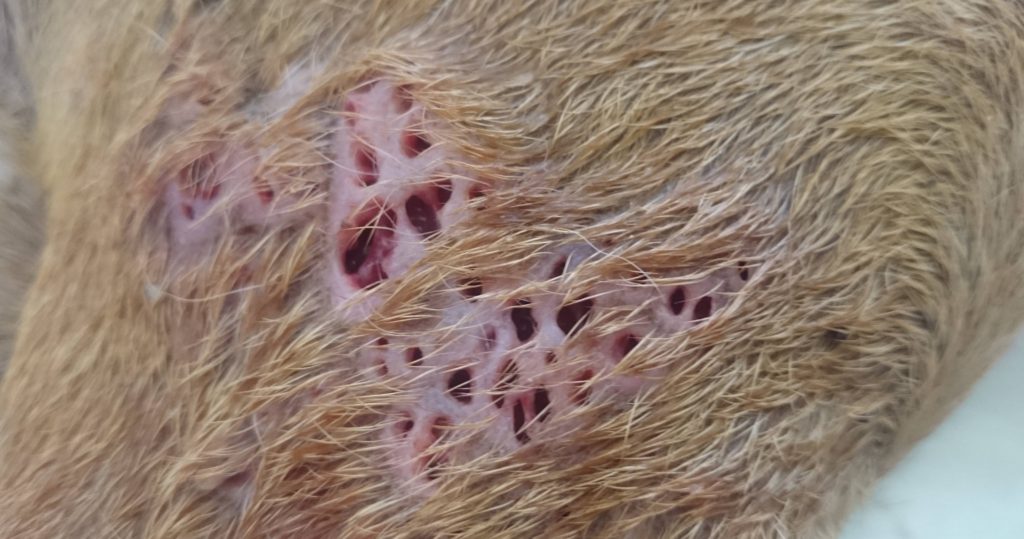Mango Worms
Mango worms are the larval parasite of a blow-fly species known as mango fly, putzi fly, or sometimes called skin maggot fly. Their Latin name, Cordylobia anthropophaga, stands for “human eater” implicating the fact that they have flesh-eating tendencies in the larval stage. They can be found throughout tropical areas of sub – Saharan region, especially in Central Africa.

Mango Fly Larvae
Mango Worms Cause Skin Infections
Like many other blowfly species, mango worms are parasitic. They usually affect mammals, so larvae burrow beneath the skin of a cat or a dog, humans included. The reaction caused by the entrance of the larva is said to be palpable for the first two days. The symptoms then subside and the infected area may be overlooked. The skin becomes inflamed, and there is tenderness on pressure. The lesion now resembles a small boil and there may be multiple sites of infection. After the period of hatching, larvae penetrate the host skin spending 8 to 10 days before they emerge as fully developed maggots. In the areas where humans habitat, they can serve as an ideal host for these parasites. Most of the patients are recorded traveling to Africa where they got the infection. Some of the most notable mango worm characteristics are:
– Female mango worms usually lay hundreds of eggs on clothing left out to dry or wet soil
– They reside in the subcutaneous tissue filled with fat, nerves and blood vessels.
– Whenever the skin is broken, there is a high chance of infection
– After 8 to 10 days mango worms form skin boils which can become itchy and extremely painful, causing also insomnia and great discomfort.
– By forming clusters of holes on the skin, they cause a condition called cutaneous myiasis. (maggot infestation)
Prevention and treatment

Dogs are most prone to infection
Even though there is no specific medical prevention for mango worm infection, there are certainly few steps you can take to minimize the risk. To avoid getting the infection through clothes, it’s best to use modern laundry facilities to machine dry the clothes or iron them after leaving it out to dry. The heat will definitely kill the mango worms before they hatch. They don’t pose a serious health risk or cause serious complications although they could be life-threatening to animal and human babies. When it comes to medical treatment, the mango worm will eventually leave the host on its own. Even though there is no specific cure for this infection, one of the ways to speed up the process is to cover the skin boil with paraffin wax or vaseline cutting off the larvae’s air supply. The mango worm will be forced to come to the surface and squeezed out. The most affected areas include buttocks, feet, legs, etc. After that, you need to disinfect the surface and, in some rare cases, use antibiotics to prevent further infection.
Trypophobia trigger
The origins of phobias have been mostly associated with the evolutionary effect. The reactions are usually based on the biological revulsion, associating some shapes with danger. Arnold Wilkins and Geoff Cole of the University of Essex’s Centre for Brain Science were the first two scientists who made a thorough research on the phenomenon known as Trypophobia. A participant on an online forum was the first to mention this term, and even though it hasn’t been officially adopted by the Diagnostic and Statistical Manual of Mental Disorders, there are many recent studies trying to explain and give detailed insights in what Trypophobia really is. In many contexts, this type of phobia cause Trypophobes to feel discomfort and panic attacks when they see a specific cluster of holes, one of them being the holes caused by emerging of mango worms out of the skin and forming specific patterns. These diseased tissues form shapes on mammal’s skin, especially dogs. Some people experienced shuddering, crawling on the skin, sweating, and the feeling of nausea and itchiness.
Psychiatrist Carol Mathews of the University of California, San Francisco, who specialized anxiety disorders, thinks that this response is due to the psychological concept known as priming and conditioning: “We all have random skin sensations, but we normally filter them out. It’s “like background noise — our brains have taught us not to listen to it. But if we’re asked to pay attention to our skin, then we start to feel all these little itches. There might really be people out there with phobias to holes because people can really have a phobia to anything,” she also stated.
Recent Research Studies

Mango Worm Infection
Most of the research studies conducted on behalf of discovering what is Trypophobia and is it a real Trypophobia agree that Trypophobes experience great discomfort upon seeing clusters of holes, protrusions, repetitive spotty patterns etc. The images that set off the feeling of repulsion, disgust and fear are usually associated to the images of some poisonous animals, like box jellyfish, cobras, which was confirmed in the study performed by the research psychologist of University of Essex, Arnold Wilkins. Two research psychologists, Kupfer and Le published an article Disgusting clusters: Trypophobia as an overgeneralized disease avoidance response arguing that Trypophobia is actually caused by the aversion to skin transmitted diseases and parasitism. Most of the infectious diseases involved irregular clusters of holes or spotty shapes on human skin. One of these diseases, cutaneous myiasis, is caused by the mango worms inhabiting the living tissue of the human skin. The myiasis caused by mango worms involves dermatologic signs of boil-like lesions. They have stated that Trypophobes actually develop an aversion to disease-relevant stimuli mostly associated with skin. The group who had reported to have Trypophobic symptoms was measured with the disgust sensitivity, developing symptoms such as skin itching and skin crawling.
More recently, a research study published in December 2017 by two scientists, Yamada and Sasaki, introduced a new hypothesis on the reasons why trypophobia occurs. This new type of hypothesis is called the “involuntary protection against dermatosis” (IPAD) hypothesis. According to the IPAD hypothesis, observers experience negative emotions on being exposed to trypophobic objects so that they can involuntarily avoid them because contagious skin diseases have a common visual pattern that is similar to that observed in Trypophobic objects.
For the first time, they acknowledged all the achievements done by other scientist trying to explain cognitive stimuli of Trypophobes. The result is based on the data obtained through an online survey through Yahoo with 1000 online participants.856 participants finished the test ( 494 males and 362 females) without knowing the purpose of conducting it. The scientists have chosen general population rather than people who have the psychological knowledge to achieve better results. They were asked to rate their discomfort on the scale from one to eleven, one being no discomfort and eleven being extremely discomfort. They were also asked to report any past experiences regarding skin diseases, which proved to be one of the crucial parameters while conducting this test.
Skin diseases, like those caused by mango worms, proved to be one of the most powerful triggers of trypophobia. The patients with the history of skin problems experienced significantly higher discomfort than those who did not encounter these problems in the past. The authors claimed that these result actually support the newly established thesis suggesting that this feeling of disgust is connected with our effort to avoid and protect ourselves from different kinds of skin infections. Trypophobic images that share the features of the cluster of holes on human or animal skin cause aversion and high level of fear or disgust.
Symptoms that are experienced by trypophobes such as panic attacks, high blood pressure, and increasing heart rate were formerly considered to be symptoms of Generalized Anxiety Disorder. However, newly conducted researches prove that there are a lot more questions to be answered here. The main causes of phobias have usually been associated with certain beliefs and cognitive biases. Our involuntary reaction to things like certain types of objects and images, or shapes on human skin is probably caused by all these features.
Dermatitis – related stimuli are just one side of this medal. These natural reactions like disgust may develop into fear over some time and then develop into a phobia, in this case, trypophobia. The persistence of fear and disgust grow over time causing different kinds of anxiety symptoms. The scientist conducting these research studies emphasized the fact that these case studies only provide a framework and that they are preliminary works providing supportive evidence that trypophobia really exists. There are a lot of questions to be assessed such as the role of gender differences, genetic influence, some other anxiety disorders etc
References
https://www.ncbi.nlm.nih.gov/pmc/articles/PMC5709931/
https://www.frontiersin.org/articles/10.3389/fpsyt.2018.00015/full#B22
http://journals.sagepub.com/doi/10.1177/0956797613484937
http://webarchive.nationalarchives.gov.uk/20121102220347/http://www.hpa.org.uk/cdr/archives/1992/cdr1092.pdf
https://www.npr.org/sections/thesalt/2013/02/13/171383429/fear-of-cantalopes-and-crumpets-a-phobia-rises-from-the-web
http://www.aavp.org/wiki/arthropods/insects/calliphoridae/cordylobia-anthropophaga/

